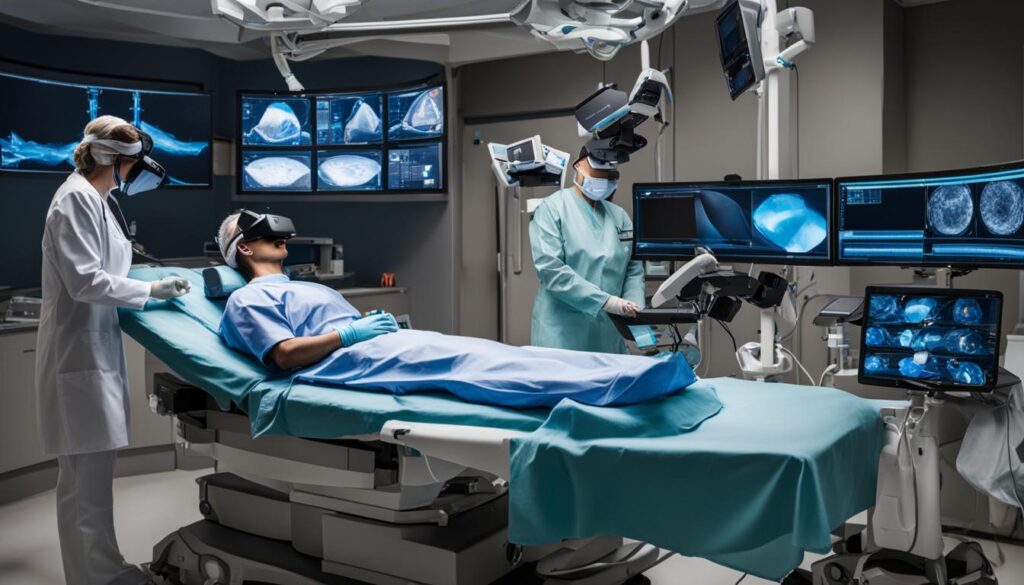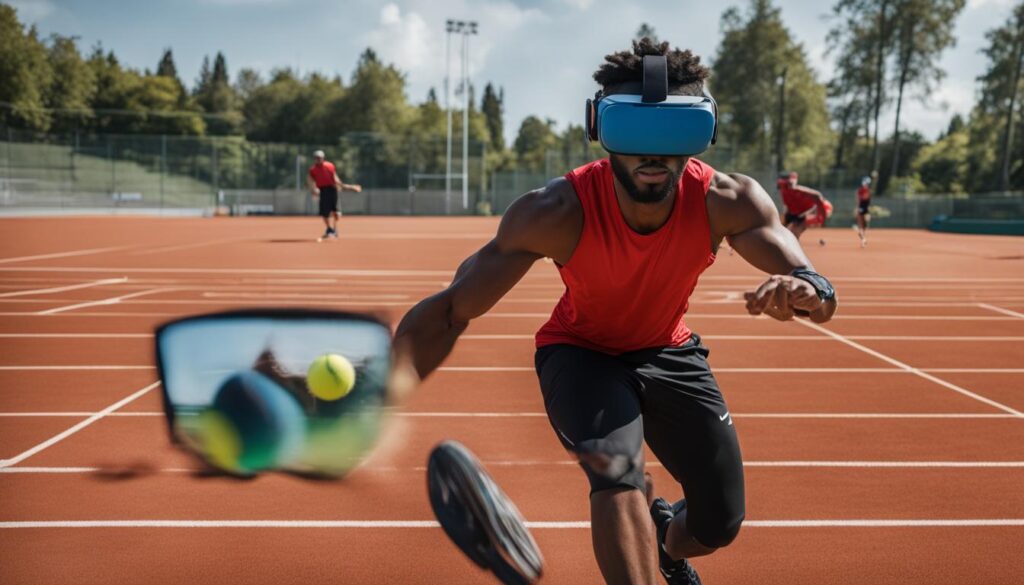Welcome to an exciting world where reality blends with imagination and technology takes us on thrilling journeys. Augmented Reality (AR) and Virtual Reality (VR) are no longer just buzzwords, but game-changing technologies transforming a wide range of industries. From gaming and entertainment to education, healthcare, architecture and design, retail, real estate, and more, AR and VR have revolutionized the way businesses operate and consumers engage with products and services.
Imagine stepping into a virtual world where you can explore new realms, interact with digital elements, and immerse yourself in breathtaking experiences. With VR headsets, players are transported to rich virtual environments, while AR overlays digital elements onto the real world, blurring the line between what’s real and what’s not.
From the immense popularity of thrilling mobile AR games like Pokémon Go to the introduction of immersive cinematic experiences and interactive storytelling, the gaming and entertainment industry has been radically transformed by AR and VR.
But the impact doesn’t stop there. Education and training have embraced these technologies, creating virtual classrooms and training simulations that allow learners to engage in hands-on experiences. Medical training has made tremendous advancements with AR and VR, enabling surgeons to practice complex procedures in virtual simulations and providing students with interactive 3D models for studying anatomy.
Healthcare has also been revolutionized by AR and VR. Surgeons can now visualize 3D models and real-time patient data during surgical planning, leading to improved precision and better patient outcomes. Additionally, these technologies offer therapeutic applications, aiding in pain management, anxiety reduction, and rehabilitation.
Architecture, design, and real estate have also experienced a significant transformation. AR and VR have enhanced visualization and communication, allowing clients and stakeholders to interact with designs in real-time and providing virtual property tours. In retail and e-commerce, AR and VR have personalized the customer journey, offering virtual fitting rooms, enhancing online shopping experiences, and boosting engagement and conversions.
Even in the world of sports, AR and VR have made their mark. Fans can now enjoy immersive sports experiences with AR overlays during broadcasts, creating interactive and engaging content. Athletes benefit from virtual training simulations, enhancing performance and skills.
The future of AR and VR in industries is bright, with continued advancements and promising developments on the horizon. These technologies hold great potential for further revolutionizing various sectors, transforming the way we work, learn, play, and interact with the world around us.
Contents
- 1 The Impact of AR & VR in Gaming and Entertainment
- 2 AR & VR’s Role in Education and Training
- 3 AR & VR Advancements in Architecture, Design, and Real Estate
- 4 The Influence of AR & VR on Retail and E-commerce
- 5 Augmented & Virtual Reality in Sports
- 6 Conclusion
- 7 FAQ
- 7.1 What industries are impacted by augmented and virtual reality?
- 7.2 How do AR and VR technologies impact the gaming and entertainment industry?
- 7.3 In what ways do AR and VR contribute to education and training?
- 7.4 What impact do AR and VR have on the healthcare industry?
- 7.5 How do AR and VR advancements influence architecture, design, and real estate industries?
- 7.6 How have AR and VR transformed the retail and e-commerce sectors?
- 7.7 What is the impact of AR and VR in the sports industry?
- 7.8 What is the future outlook for AR and VR in various industries?
- 8 Source Links
Key Takeaways:
- AR and VR have revolutionized various industries, including gaming, entertainment, education, healthcare, architecture and design, retail, real estate, and more.
- AR overlays digital elements onto the real world, while VR transports users to rich virtual environments.
- AR and VR have transformed gaming and entertainment, offering immersive experiences and interactive storytelling.
- In education and training, AR and VR provide hands-on learning experiences, virtual classrooms, and medical simulations.
- AR and VR have revolutionized healthcare, improving surgical planning, medical training, and patient care.
The Impact of AR & VR in Gaming and Entertainment
AR and VR technologies have revolutionized the gaming and entertainment industry, providing users with immersive experiences that blur the line between the virtual and physical worlds. With VR headsets, players are transported into rich virtual environments, where they can interact and engage with the game’s surroundings.
On the other hand, AR overlays digital elements onto the real world, creating interactive experiences that enhance storytelling and gameplay. One popular example is the mobile AR game Pokémon Go, which gained massive popularity by allowing players to capture Pokémon in their real-world surroundings.
The rise of VR has also introduced immersive cinematic experiences, where viewers can be fully immersed in a virtual movie or series, simulating a theater-like environment. These experiences allow users to be a part of the storyline and offers a new level of engagement.
Moreover, AR has enhanced storytelling by incorporating interactive elements into content. AR filters and overlays have become popular in various forms of entertainment, allowing users to create engaging and personalized experiences by adding digital enhancements to their photos and videos.
The combination of AR and VR has not only transformed the way we play games and consume entertainment but has also opened up new avenues for creativity and interaction. The possibilities are endless, and the gaming and entertainment industry continues to push the boundaries of what AR and VR experiences can offer.
AR and VR Experiences in Gaming and Entertainment
The impact of AR and VR experiences can be seen in various aspects of gaming and entertainment:
- Immersive gameplay that transports players into virtual worlds
- Interactive storytelling through AR overlays and filters
- Virtual reality cinematic experiences that provide a new level of engagement
- Mobile AR games that blend the real and virtual worlds
- AR-enhanced content creation and personalized experiences
The integration of AR and VR in gaming and entertainment has revolutionized the industry, offering users unprecedented levels of immersion and interactivity. Whether it’s exploring virtual worlds, interacting with digital elements in the real world, or experiencing immersive cinematic adventures, AR and VR have transformed the way we experience and engage with games and entertainment.
AR & VR’s Role in Education and Training
AR and VR technologies have revolutionized education and training, providing immersive and interactive learning experiences that enhance engagement and knowledge retention. From virtual classrooms to medical training, these technologies have transformed traditional teaching methods and opened up new possibilities for learners.
The Power of Virtual Classrooms
Virtual classrooms offer a unique learning environment where students can step into realistic virtual settings, regardless of their physical location. Through AR and VR, learners can engage with 3D models, simulations, and interactive content, making complex subjects more accessible and enjoyable. This technology enables hands-on learning, critical thinking, and problem-solving skills development in a safe and controlled virtual space.
Enhancing Medical Training with AR and VR
AR and VR have particularly revolutionized medical training, providing surgeons with realistic simulations and virtual environments to practice complex procedures. Surgeons can refine their skills, improve precision, and explore innovative techniques without risks to patients. Additionally, AR and VR offer medical students interactive 3D models for studying human anatomy, promoting a deeper understanding of the human body.
Remote Learning Opportunities
AR and VR technologies have also opened up remote learning opportunities, allowing students to access educational experiences and resources regardless of their physical location. With virtual reality headsets and AR-enabled devices, learners can connect with experts, join virtual field trips, and explore new cultures and environments from the comfort of their homes. These technologies bridge geographical barriers and provide equal access to high-quality education.
Enhanced Employee Training
AR and VR are not limited to traditional education settings. They have proven to be invaluable tools for employee training in various industries. From technical skills development to safety training, these technologies offer realistic simulations and interactive modules that enhance employee performance and productivity. Companies can provide immersive training experiences that replicate real-world scenarios, preparing employees for challenges in a controlled and engaging environment.
| Benefits of AR and VR in Education and Training |
|---|
| Enhances engagement and knowledge retention |
| Provides hands-on and interactive learning experiences |
| Enables remote learning opportunities |
| Facilitates realistic simulations and practice scenarios |
| Promotes critical thinking and problem-solving skills |

AR & VR Advancements in Architecture, Design, and Real Estate
Augmented Reality (AR) and Virtual Reality (VR) have revolutionized the fields of architecture, design, and real estate by offering innovative solutions for visualization and communication. These technologies have transformed the way professionals in these industries work, enabling them to create immersive and interactive experiences for their clients and stakeholders.
One of the significant benefits of AR and VR in architecture and design is the ability to interact with designs in real-time. With AR and VR applications, you can manipulate 3D models, explore different design options, and make informed decisions through virtual walkthroughs and simulations. This level of interactivity enhances communication between architects, designers, and clients, reducing misunderstandings and improving collaboration.
AR and VR also play a crucial role in the real estate industry by offering virtual property tours and visualizing finishes and furniture. With virtual tours, potential buyers can explore properties and get a realistic sense of the space without physically visiting it. AR visualization allows them to see how different furniture and finishes would look in the space, aiding in decision-making.
Furthermore, these technologies provide invaluable resources for architectural and design education. Students can immerse themselves in virtual environments, gaining practical experience and refining their design skills. AR and VR simulations allow them to experiment with different design concepts, understand spatial relationships, and visualize their ideas in a tangible way.
Benefits of AR & VR in Architecture, Design, and Real Estate:
- Enhanced visualization: AR and VR technologies provide realistic and immersive visualizations, allowing stakeholders to better understand design concepts and make informed decisions.
- Improved communication: The interactive nature of AR and VR facilitates effective communication between architects, designers, and clients, ensuring a shared vision and reducing errors.
- Virtual property tours: Potential buyers can explore properties remotely through virtual tours, saving time and providing a realistic experience.
- Design experimentation: AR and VR simulations enable architects and designers to experiment with various design options, test different materials and finishes, and refine their concepts.
- Practical architectural and design education: Students can gain practical experience and refine their design skills through virtual environments and simulations, preparing them for real-world projects.
AR and VR have truly transformed the way architecture, design, and real estate professionals work, enhancing visualization, communication, and decision-making processes. As these technologies continue to evolve, they will undoubtedly shape the future of these industries, facilitating even more immersive and impactful experiences.

Table: Examples of AR and VR Applications in Architecture, Design, and Real Estate
| Industry | Application |
|---|---|
| Architecture | Real-time visualization of designs |
| Design | Virtual walkthroughs and simulations |
| Real Estate | Virtual property tours with AR overlays |
| Education | Interactive architectural and design education |
The Influence of AR & VR on Retail and E-commerce
The retail and e-commerce sectors have experienced a significant transformation with the advent of Augmented Reality (AR) and Virtual Reality (VR) technologies. These immersive technologies have revolutionized customer experiences, providing unique and interactive shopping journeys.
AR technology enables customers to virtually try on products, eliminating the need for physical fitting rooms. By simply using their smartphones or tablets, customers can visualize how clothing items or accessories will look on them. This virtual fitting experience enhances convenience and reduces the hassle of returning ill-fitting garments. It also opens up new possibilities for personalized recommendations based on individual body measurements and style preferences.
Furthermore, AR enhances the online shopping experience by allowing customers to visualize how furniture or home decor items will look in their own homes. By overlaying digital images onto real-time camera views, customers can see how different pieces will fit into their existing spaces. This realistic visualization feature eliminates the need for guesswork when making purchasing decisions and enhances customer satisfaction.
On the other hand, VR technology offers virtual stores and shopping experiences. Customers can enter a virtual environment from the comfort of their own homes and navigate through 3D representations of products. This immersive shopping experience provides a sense of presence and allows customers to explore and interact with products in a realistic way. It also enables retailers to showcase a wider range of products in a limited physical space, offering customers a more extensive selection.
AR and VR technologies have the potential to revolutionize the retail and e-commerce sectors, providing personalized and immersive shopping experiences. By implementing these technologies, retailers can increase customer engagement, boost conversions, and differentiate themselves in a highly competitive market.
Augmented & Virtual Reality in Sports
Augmented Reality (AR) and Virtual Reality (VR) technologies have made their way onto the playing fields, enhancing the sports experience for fans and athletes alike. These immersive technologies have revolutionized sports broadcasting and in-stadium experiences, providing interactive and engaging content through AR overlays.
Sports channels now utilize AR overlays to highlight real-time information during broadcasts, such as player statistics, replays, and interactive graphics. This not only enhances viewer engagement but also provides a deeper understanding of the game.
AR and VR also open up a world of virtual sporting experiences. Fans can now step into the shoes of their favorite athletes and experience the thrill of sports firsthand through VR simulations. Imagine standing on the tennis court alongside Serena Williams or taking a penalty shot against a legendary goalkeeper. These experiences bring fans closer to the action and create unforgettable memories.
Aside from engaging fans, AR and VR have also revolutionized athlete training. Virtual simulations enable athletes to practice their skills in immersive environments, enhancing their performance and decision-making abilities. Training scenarios can be recreated with precision, allowing athletes to refine their techniques and strategize for upcoming competitions.
AR and VR have transformed the sports industry, creating immersive and interactive experiences that were once unimaginable. From providing real-time insights to virtual sporting experiences, the advancements in AR and VR are shaping the future of sports.
AR and VR in Sports Broadcasting
AR overlays in sports broadcasting have taken the viewer experience to the next level. Through these overlays, viewers can now access real-time statistics, player profiles, and interactive graphics, enhancing their understanding and enjoyment of the game. This technology adds a new layer of engagement and interactivity, creating a more immersive sports-watching experience.
For example, during a football match, AR overlays can display the distance covered by players, the speed of the ball, or even the estimated trajectory of a free kick. These real-time insights provide viewers with a deeper understanding of the game and enhance their overall experience.
Furthermore, AR overlays can also be used to display virtual ads and sponsored content, seamlessly integrating advertisements into the sports broadcast. This not only provides revenue opportunities for sports networks but also delivers a more tailored and immersive advertising experience for viewers.
Virtual Sporting Experiences and Immersive Training
AR and VR technologies have also enabled virtual sporting experiences, allowing fans to participate in their favorite sports without stepping foot on the field. Virtual reality simulations allow fans to experience the exhilaration of skiing down a mountain, hitting a hole-in-one on a golf course, or scoring the winning goal in a soccer match.
Moreover, VR simulations have transformed training for athletes. By creating realistic virtual environments, athletes can practice their skills, analyze their performance, and make improvements in a safe and controlled setting. These immersive training experiences help athletes push their boundaries and reach their full potential.
| Benefits of AR and VR in Sports | Examples |
|---|---|
| Enhanced viewer engagement | Interactive AR overlays during live broadcasts |
| Deeper understanding of the game | Real-time player statistics and replays |
| Virtual sporting experiences | VR simulations of skiing, golfing, soccer, etc. |
| Improved athlete training | Realistic VR simulations for practice and analysis |
 AR and VR technologies have transformed the sports industry, providing immersive experiences and enhancing the way fans engage with their favorite sports. From AR overlays in sports broadcasting to virtual sporting experiences and immersive athlete training, these technologies have taken sports to new heights.
AR and VR technologies have transformed the sports industry, providing immersive experiences and enhancing the way fans engage with their favorite sports. From AR overlays in sports broadcasting to virtual sporting experiences and immersive athlete training, these technologies have taken sports to new heights.
Conclusion
The implementation of Augmented Reality (AR) and Virtual Reality (VR) technologies has transformed various industries, revolutionizing the way businesses operate and customers engage with products and services. From gaming and entertainment to healthcare, education, architecture, design, retail, and more, AR and VR have reshaped the landscape of these sectors by offering immersive and interactive experiences.
The future of AR and VR in industries holds immense potential for further advancements. As technology continues to evolve, we can expect even more innovative applications and integrations. The implementation of AR and VR will continue to enhance engagement, education, and customer experiences, creating new opportunities and improving existing processes.
AR and VR have already proven their worth in gaming and entertainment, transportation and logistics, training and education, and healthcare. They have facilitated remote learning, transformed the way surgeries are planned and performed, and revolutionized the way we shop and interact with products. As AR and VR technologies become more accessible, we can anticipate their implementation in sectors such as real estate, manufacturing, tourism, and beyond.
The future of AR and VR in industries is bright, with the potential for groundbreaking innovations and transformative changes. As businesses embrace these technologies, they will continue to push boundaries and unlock new possibilities for improved productivity, enhanced customer experiences, and industry growth. By harnessing the power of AR and VR, businesses can stay at the forefront of innovation and drive their industries forward.
FAQ
What industries are impacted by augmented and virtual reality?
Augmented and virtual reality technologies have revolutionized various industries, including gaming, entertainment, education, healthcare, architecture and design, retail, real estate, and more.
How do AR and VR technologies impact the gaming and entertainment industry?
AR and VR offer immersive experiences that blur the line between virtual and physical worlds. VR headsets transport players into rich virtual environments, while AR overlays digital elements onto the real world, creating interactive experiences.
In what ways do AR and VR contribute to education and training?
AR and VR provide interactive learning experiences, allowing learners to step into realistic virtual environments. Virtual classrooms and training simulations foster hands-on learning. Medical training specifically benefits from AR and VR, enabling surgeons to practice complex procedures and providing students with interactive 3D models for studying anatomy.
What impact do AR and VR have on the healthcare industry?
AR and VR technologies enhance medical training by providing realistic simulations and virtual environments for practicing complex procedures. Surgeons can visualize and interact with 3D models and real-time patient data during surgical planning, improving precision and accuracy. These technologies also offer therapeutic applications, aiding in pain management, anxiety reduction, and rehabilitation.
How do AR and VR advancements influence architecture, design, and real estate industries?
AR and VR enhance visualization and communication in architecture, design, and real estate. Clients and stakeholders can interact with designs in real-time and experience virtual walkthroughs and simulations. AR applications enable virtual property tours and visualize furniture and finishes, aiding decision-making in real estate. These technologies also facilitate architectural and design education, providing practical experience and refining design skills.
How have AR and VR transformed the retail and e-commerce sectors?
AR technology allows customers to virtually try on products, visualize furniture in their homes, and enhance the online shopping experience. VR offers virtual stores and experiences, providing a 3D representation of products and immersive shopping environments. AR and VR personalize the customer journey, providing personalized recommendations and increasing engagement and conversions in e-commerce.
What is the impact of AR and VR in the sports industry?
AR and VR provide immersive experiences in sports, enhancing broadcasting and in-stadium experiences. Sports channels utilize AR overlays to highlight real-time information during broadcasts, creating interactive and engaging content. AR and VR also enable virtual sporting experiences and immersive training simulations for athletes, enhancing the overall sports experience for fans and athletes alike.
What is the future outlook for AR and VR in various industries?
The integration of AR and VR technologies has had a significant impact on various industries and will continue to evolve and revolutionize sectors like gaming, entertainment, education, healthcare, architecture and design, retail, real estate, and more. AR and VR offer immersive and interactive experiences, enhancing engagement, education, customer experiences, and overall industry advancements.




